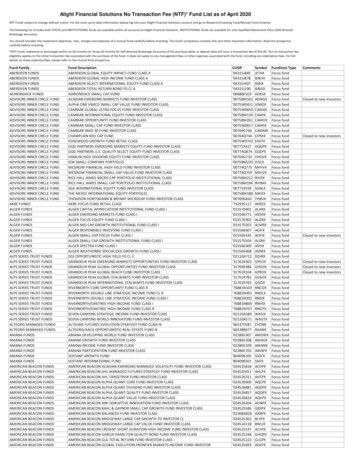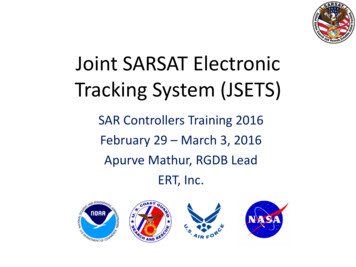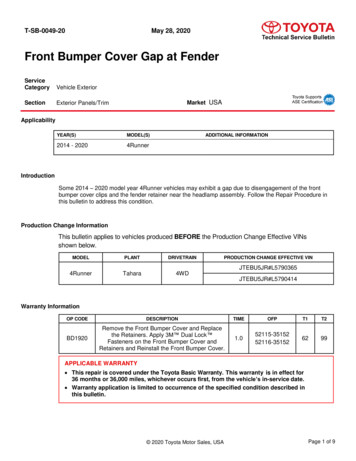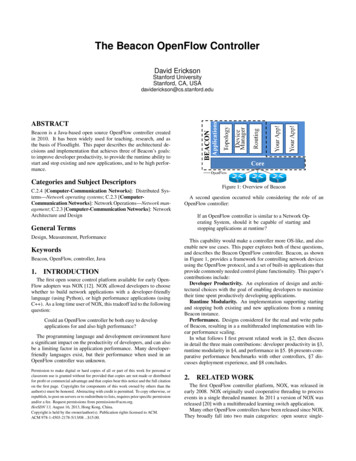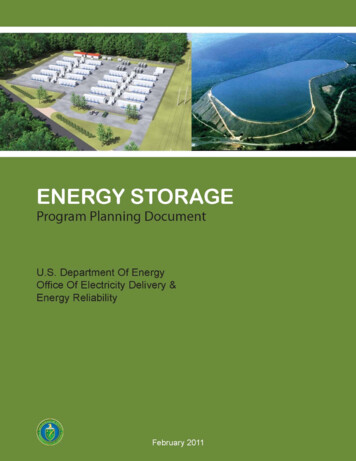
Transcription
1
Images—Front cover: 20MW Beacon Power flywheel storage facility; Ameren’s 440MWpumped-hydro storage at Taum Sauk, Missouri. Back cover: 8MW SCE / A123 Lithium-ionstorage at Tehachapi wind farm; 25MW Primus Power flow battery at Modesto, California;110MW compressed air energy storage in McIntosh, Alabama.
TABLE OF CONTENTSExecutive Summary. 11.0 Introduction to the OE Storage Program . 51.1. The Grid Energy Storage Value Proposition . 51.2. Grid Energy Storage at DOE . 81.3. DOE’s Partnership Strategies. 122.0 Challenges and Needs. 143.0 Analysis, Research & Development and Demonstration Program. 163.1. Current State of Electric Storage. 173.2. The Research & Development Component of the Program. 193.3. The Demonstration Component of the Program . 223.4. The Analysis Component of the Program. 284.0 Portfolio Development and Management. 31Acronyms & Abbreviations. 32
EXECUTIVE SUMMARYEnergy storage systems have the potential to extend and optimize the operating capabilities of the grid,since power can be stored and used at a later time. This allows for flexibility in generation anddistribution, improving the economic efficiency and utilization of the entire system while making the gridmore reliable and robust. Additionally, alternatives to traditional power generation, including variablewind and solar energy technologies, may require back-up power storage. Thus, modernizing the powergrid may require a substantial volume of electrical energy storage (EES).The Office of Electricity Delivery & Energy Reliability (OE) is taking leadership on energy storage toensure that the technologies live up to their potential, and will assist in bringing these solutions into thecommercial market. OE’s vision of the Program is based on four principles:¾ Understanding where to put energy storage on the system for the best value¾ Developing and driving performance targets—e.g., cost, safety, cycle life¾ Partnering to get the most value, specifically using research, development and demonstrations tounderstand the value chain, and then using feedback from demonstrations to guide the science inways for improvements, and¾ Focusing on engineering that is necessary for manufacturing.OE is providing assistance in three main areas: research, demonstrations/deployments, and systemsanalysis.¾ Research is focused on technologies that store electricity in chemicals or batteries, includingsodium (Na) based batteries, lithium-ion (Li-ion) battery applications for grid scale systems,advanced lead-acid batteries, and flow batteries. Research is also supported for other categoriesof technologies, such as superconducting magnetic energy storage (SMES), ultra-capacitors,advanced materials for flywheels, and geological aspects of compressed air energy storagesystems (CAES).¾ Demonstrations, including deployments within commercial-scale systems, are focused onadvancements in the above mentioned batteries, flywheels, CAES, etc. There is some work, alsorelated to advancements in power electronics and control systems as applied to energy storage.¾ Systems analysis is mainly on the effective integration of storage options within energy balancingareas/authorities.The energy storage program at OE is designed to advance all these areas and technologies. The Programis positioning to reach the Department’s 2015 target of reducing the cost of energy storage by 30%.Assuming a funding level of approximately 200 million over the next five years (2011 to 2015), theProgram has set for itself a number of objectives:1
Near-term Objectives (within 5 years)Longer-term ObjectivesRelated to Research and Development Ensure that new, promising technologies are addedto the pipeline for research and verificationFocus at the device level, and the elements needed tofully integrate devices into systemsTest technologies so that device reliability will beraised sufficiently resulting in demonstration use byutilitiesWork with SBIRs, EFRCs, and ARPA-E, andthrough university solicitations, to mine sources ofideas. Initiate efforts in discovering new materialsand chemistries to lead new EES technologiesDevelop and optimize EES redox flow batteries, Nabased batteries, lead-carbon batteries, Li-ion batteriesto meet the following performance and cost targets:System capital cost: under 250/kWhLevelized cost: under 20 /kWh/cycleSystem efficiency: over 75%Cycle life: more than 4,000 cyclesDevelop and optimize power technologies to meetcapital cost targets under 1,750/kW Simultaneously filter out less-promisingtechnologies while keeping the research pipelinefilled so that the level of innovation remainsrobustMaintain momentum for promising technologiesidentified in the research phaseDevelop new technologies based on previouslydiscovered materials and chemistries to meet thefollowing targets:System capital cost: under 150/kWhLevelized cost: under 10 /kWh/cycleSystem efficiency: over 80%Cycle life: more than 5,000 cyclesDevelop and optimize power technologies tomeet capital cost targets under 1,250/kWRelated to Demonstrations Capitalize on the significant momentum gained byRecovery Act demonstration projectsWorking with utilities, storage providers, andrenewable energy integrators to target specificdemonstrations that will have high leverage (and costsharing)Analyze current Recovery Act demonstrations earlyto understand what is working and what can beimproved and feed that information back into currentdemonstration decisions; don’t wait for the RecoveryAct demonstrations to be “complete” in order to useresults and feedback Maintain a pipeline of viable demonstrationprojects that advance the knowledge of storagesystems as well as verify the reliability of ESSRe-deploy electric vehicle batteries after theiruseful life in vehicles as part of a grid storagesystemDemonstrate configurations for test-beddistributed generations systems and storageconnected houses (“community energy storage”)Demonstrate configurations for test-bed storagelinked with demand responseTo implement the above objectives, OE has set a number of specific milestones for each the next fiveyears, as depicted on the following two pages.2
Energy Storage Program Milestones20112012 terychemistry,chemistry,suchsuch asasthosethosebasedbased rateaa50%50%increaseincreaseinin edoxflowflowtechnologytechnology AwardAward 2.8M orAppliedApplied EnergyEnergyStorageStorageResearchResearch CompleteCompletesystemsystemdesigndesign ofofWindWind werPowerEnergy Farm gionalneedsneeds ofofelectricenergystorageneedselectric energy storage needs CompleteComplete 8,0008,000utilityutility cyclescyclesonon rundertesttestwithwith lesslessthanthan 2,0002,000cyclescycles InstallInstallandand commissioncommission aa PVPV PbCPbC aneousVoltageVoltageSmoothingSmoothingandand PeakPeak NM batteriesthatthatareare DevelopDevelop uniqueuniqueLi‐ionLi‐ion fectiveelectrodeelectrodematerialsmaterialsandand fe( 4,000( 4,000cycles)cycles) LaunchLaunch archresearchfocusingfocusingonon nextnextgenerationgeneration ofofbatteriesbatteries mprogrambetweenbetween SNLSNLandandEastEastPennPenn totodevelopdevelop dingforforenhancedenhanced teriesadvanced leadleadacid CompleteCompletefabricationfabrication electrosynthesiselectrosynthesisofofbulkbulkGaNGaN ContinueEnergySuretyMicrogrid Continue Energy Surety lopment andanddemonstrationdemonstration programsprogramsforforselectselectsitessites Install orforgridgrid scalescaledemodemoofofancillaryancillary gManufacturing Complete Complete manufacturemanufactureandandassemblyassembly ressed onProduction––SustainXSustainX Report Reportononinstitutionalinstitutional ergyenergystoragestorage based Complete cost model for RedoxFlowbatterybattery Report onstrationProjectsProjects Analysis st‐performancetargetstargetsforforenergyenergy storagestorage Complete Complete onRegulation PlantPlantininPJM.PJM.‐‐BeaconBeacon PowerPower Demonstrate h‐topbench‐topbatteriesbyby developmentdevelopmentofstackstack ,,thatthatcancan leadlead toto 250/kWh 250/kWh Demonstrate eofofsatisfactorysatisfactory operationoperationatatotemperaturestemperatures 250 250oCC CompletePrototype Complete iumIonIonBatteryBattery forforGridGridLevelLevelApplicationApplication –Aquion–Aquion Publish Publishreportreportonon gulatoryregulatory andand legislativelegislativeaudiences.audiences. Initiate Initiatenewnewstatestateenergyenergy storagestoragecollaborationcollaboration Develop Developadvancedadvanced membranesmembranesforforflowflowbatteriesbatteries Demonstratetheradialradial Demonstratesynthesissynthesisofofbulkbulk GaNGaNinintheflowflowreactorreactor Demonstrated ed compositescompositesforforflywheelsflywheels Complete Completelaboratorylaboratorycellcelldesigndesign andand testingtestingofofsodium‐ionsodium‐ion batterybattery3
Energy Storage Program Milestones2013 Optimize gndesignandanddevelopdevelop dround triptrip efficiencyefficiency ( 75%),( 75%),viaviacollaborationcollaboration withwith industriesindustries ComprehensiveUS Comprehensive USgridgrid estorage Scale Scaleupup tesizesizemulti‐multi‐cellcellstacksstacks Report Report onon gridgrid ationdemonstration projectsprojects Develop Developadvancedadvanced metal‐airmetal‐air flowflowbatterybattery Report Report onon adoptionofofstoragestorage Complete Completefabricationfabrication andand testingtestingofofMeTILs‐basedMeTILs‐based flowflowbatterybatteryprototypeprototype Demonstrate ylaboratorycellcellprototypeprototype Adopt Adoptandand tioncarboncarbon enhancementenhancementofofadvancedadvanced tingleadleadacidacidbatterybatterydesignsdesigns Fabricate Fabricateandand testtest rrotordesignsdesigns Demonstrate aboratorylaboratory batterybatterycellcell2014 Scale Scaleupup andand developdevelop practicalpracticalsizesize redoxredoxflowflowbatterybattery system,system,viaviacollaborationcollaboration withwith industriesindustries Develop Developandanddemonstratedemonstrate aafullfullsizesizebench‐topbench‐top tterybattery Demonstrate wbatterybattery Complete opmentforforsizing,sizing,locating,locating,andand bulkbulkpowerpowersystemssystems Demonstrate Demonstratescaled‐upscaled‐up totype Complete neration carboncarbon enhancedenhancedleadlead acidacidbatteriesbatteries Prepare PrepareGaNGaNcrystalcrystalinin bulkbulkquantityquantity usingusingradialradialflowflowreactorreactor Fabricate orycellcellprototypeprototype Fabricate etestingtesting42015 Field Field testtestthethenewnewgenerationgeneration redoxredoxflowflowbatterybattery system,system, viaviacollaborationcollaboration withwithutilityutilityindustriesindustries Complete Completeplanningplanning g,locating,locating,andand dispatchdispatch ofofenergyenergy ystems Develop Developandanddemonstratedemonstrate5kW5kW actorysatisfactoryooperationoperation 250 250oCC Demonstratea Demonstrate amulti‐multi‐kwhkwhbench‐topbench‐top metal‐airmetal‐airflowflowsystemsystem Complete ybattery prototypeprototypetestingtesting Fabricate terybatteryprototypeprototype Complete ssembled hublesshublessrotorrotorprototypeprototype Complete ‐sodium‐brominebrominebatterybattery Fabricate ory prototypeprototype
1.0 INTRODUCTION TO THE OE STORAGE PROGRAMModernizing the power grid will help the nation meet the challenge of a more technologically advanced,reliable system, one able to handle the projected volumes of energy required. There are estimates that by2050 North America will need somewhere between 15 and 20 terawatt-hours of electric power annually.1This growth will increase pressure on finding the sources of power generation required, as well asensuring that systems have lower carbon emissions, be more economical and commercially viable, and beenvironmentally sustainable.Energy storage systems have the potential to extend and optimize the operating capabilities of the grid,since power can be stored and used at a later time. This allows for flexibility in generation anddistribution, improving the economic efficiency and utilization of the entire system while making the gridmore reliable and robust. Additionally, alternatives to traditional power generation, including variablewind and solar energy technologies, may require back-up power storage. Thus, modernizing the powergrid may require a substantial volume of electrical energy storage (EES); the total requirement for U.S.bulk storage over the next 5-10 years has been estimated at between 10 and 100 gigawatts.2In addition to large-scale grid applications, energy storage can be effective in designing smart microgridson the residential or commercial building level, with storage as part of an integrating controller systemcontributing to grid stability. Convergence of a number of issues, such as community energy storage,second use of vehicular batteries, smart charging for plug-in electric vehicles, and the increasing use ofrooftop solar will pose challenges to grid reliability while providing opportunities for the development ofoptimized storage systems.In the three years since the inception of the Office of Electricity Delivery & Energy Reliability (OE) theOffice has been working to stimulate investment in electric and energy infrastructure, advance the state ofscientific development in supply and demand side electric technologies, identify barriers to continuedreliable electric service, deepen consideration of security and resiliency measures in infrastructureplanning, and expand partnerships with State and private-sector stakeholders. Supporting energy storageefforts is central to OE’s mission as it facilitates the creation, advancement, and deployment of the newtechnologies that will ensure a truly modern and robust grid capable of meeting the demands of the 21stcentury.1.1. The Grid Energy Storage Value PropositionFor the past decade, industry, utilities, and the Department have known that energy storage can be animportant element of future grids, and energy storage is becoming a more pressing issue. A number ofindustry changes are happening:¾ States are requiring utilities to include energy storage in their portfolio¾ Energy storage is being looked to for increasing the penetration of renewable energy on1U.S. DOE, “National Electric Delivery Technologies Vision and Roadmap,” November 2003.2Ibid.5
the grid to meet renewable portfolio standards¾ Energy storage is being assessed for enhancing existing—and aging—electric systemcapital assets, thereby increasing the reliability of electricity transmission and distribution¾ Smart Grid deployment may require wide-scale energy storage in order to achieve its fullpotential and deliver on its value proposition, and¾ Energy storage will be needed to support the electrification of the transportation sector.Energy storage is poised to grow from 1.5 billion in 2010 to a 35 billion industry by 2020.3 To helpshape the impact of energy storage, the Department has a mission to help facilitate the development of arobust manufacturing base of advanced energy storage devices in the U.S. Cost effective energy storagewill be a key element in ensuring the successful deployment of the grid of the future, and the Departmenthas set a target of reducing the cost of energy storage by 30% by 2015.Figure 1-1, on the next page, summarizes 12 of the most common types of value propositions—orapplications—associated with specific energy storage technologies; there are also 7 types of technologiespresented.4 It is worth noting that not all energy storage technologies are at the same level of commercialreadiness. Equally important, specific technologies can provide more than one type of value. As a result,determining the exact value proposition for energy storage requires an analysis of each system. As moretechnologies are demonstrated and deployed, the determination of value will become easier.34Pike Research, “Energy Storage on the Grid,” August 2010.Figure is an OE created diagram derived from industry presentations, including material from Southern California Edison.6
Figure 1-1. Principal Energy Storage Applications and Technologies7UUUUPUUUse an energy storage device to defer upgrades intransmissionUse an energy storage device to defer upgrades indistributionUse a transportable storage unit to provide supplementalpower to end users during outages due to short termdistribution overload situationsCharge device during off peak downstream of thedistribution system (below secondary transformer);discharge during 2‐4 hour daily peekCharge/Discharge device to balance local energy use withgeneration. Sited between the distributed and generationand distribution grid to defer otherwise necessarydistribution infrastructure upgradesCharge device when retail TOU prices are low anddischarge when prices are highEnd user deploys energy storage to improve powerquality and /or provide back up power during outagesEnergy storage is deployed in conjunction with localgeneration to separate from the grid, creating an level outagemitigationPeak loadshiftingdownstream ionintegrationEnd‐user time‐of‐use rateoptimizationUninterruptiblepower supplyMicro gridformation; Possible use for applicationPUnit sits fully charged, discharging when black startcapability is requiredBlack startprovisionDefinite suitability for applicationPProvide ancillary service capacity in day ahead marketsand respond to ISO signaling in real timeAncillary serviceprovisionUUPUUUUUPPUPPumpedHydro; Unsuitable for applicationUUCharge/discharge seconds to minutes to smoothintermittent generation and/or charge/discharge minutesto hours to shape energy profileOn‐peakintermittentenergysmoothing andshapingPCAESCharge at the site of off peak renewable and/ orintermittent energy sources; discharge energy into thegrid during on peak periodsDescriptionOff‐to‐on peakintermittentshifting DDPPDDDDDPDDFlowBatteries
1.2. Grid Energy Storage at DOEOE is taking leadership on energy storage to ensure that the technologies live up to their potential, andwill assist in bringing these solutions into the commercial market. OE’s vision of the Program is based onfour principles:¾ Understanding where to put energy storage on the system for the best value¾ Developing and driving performance targets—e.g., cost, safety, cycle life¾ Partnering to get the most value, specifically using research, development and demonstrations tounderstand the value chain, and then using feedback from demonstrations to guide the science inways for improvements, and¾ Focusing on engineering that is necessary for manufacturing.OE is providing assistance in three main areas: research, demonstrations/deployments, and systemsanalysis.¾ Research is focused on technologies that store electricity in chemicals or batteries, includingsodium (Na) based batteries, lithium-ion (Li-ion) battery applications for grid scale systems,advanced lead-acid batteries, and flow batteries. Research is also supported for other categoriesof technologies, such as superconducting magnetic energy storage (SMES), ultra-capacitors,advanced materials for flywheels, and geological aspects of compressed air energy storagesystems (CAES).¾ Demonstrations, including deployments within commercial-scale systems, are focused onadvancements in the above mentioned batteries, flywheels, CAES, etc. There is some work, alsorelated to advancements in power electronics and control systems as applied to energy storage.¾ Systems analysis is mainly on the effective integration of storage options within energy balancingareas/authorities.Additionally, this program, the Energy Storage Systems Program (ESSP), provides neutral third-partytesting for developers of energy storage components and systems. These bench, prototype, and fieldtesting capacities provide industry with critical feedback on technology and design throughout thedevelopment process, and enable more effective integration of new storage technologies into the grid.The energy storage program at OE is designed to advance all these areas and technologies. The Programis positioning to reach the Department’s 2015 target of reducing the cost of energy storage by 30%.Assuming a funding level of approximately 200 million over the next five years (2011 to 2015), theProgram has set for itself a number of objectives:8
Near-term Objectives (within 5 years)Longer-term ObjectivesRelated to Research and Development Ensure that new, promising technologies are addedto the pipeline for research and verificationFocus at the device level, and the elements needed tofully integrate devices into systemsTest technologies so that device reliability will beraised sufficiently resulting in demonstration use byutilitiesWork with SBIRs, EFRCs, and ARPA-E, andthrough university solicitations, to mine sources ofideas. Initiate efforts in discovering new materialsand chemistries to lead new EES technologiesDevelop and optimize EES redox flow batteries, Nabased batteries, lead-carbon batteries, Li-ion batteriesto meet the following performance and cost targets:System capital cost: under 250/kWhLevelized cost: under 20 /kWh/cycleSystem efficiency: over 75%Cycle life: more than 4,000 cyclesDevelop and optimize power technologies to meetcapital cost targets under 1,750/kW Simultaneously filter out less-promisingtechnologies while keeping the research pipelinefilled so that the level of innovation remainsrobustMaintain momentum for promising technologiesidentified in the research phaseDevelop new technologies based on previouslydiscovered materials and chemistries to meet thefollowing targets:System capital cost: under 150/kWhLevelized cost: under 10 /kWh/cycleSystem efficiency: over 80%Cycle life: more than 5,000 cyclesDevelop and optimize power technologies tomeet capital cost targets under 1,250/kWRelated to Demonstrations Capitalize on the significant momentum gained byRecovery Act demonstration projectsWorking with utilities, storage providers, andrenewable energy integrators to target specificdemonstrations that will have high leverage (and costsharing)Analyze current Recovery Act demonstrations earlyto understand what is working and what can beimproved and feed that information back into currentdemonstration decisions; don’t wait for the RecoveryAct demonstrations to be “complete” in order to useresults and feedback Maintain a pipeline of viable demonstrationprojects that advance the knowledge of storagesystems as well as verify the reliability of ESSRe-deploy electric vehicle batteries after theiruseful life in vehicles as part of a grid storagesystemDemonstrate configurations for test-beddistributed generations systems and storageconnected houses (“community energy storage”)Demonstrate configurations for test-bed storagelinked with demand responseTo implement the above objectives, OE has set a number of specific milestones for each the next fiveyears, as depicted in Figure 1-2, on the following two pages.9
Energy Storage Program Milestones20112012 terychemistry,chemistry,suchsuch asasthosethosebasedbased rateaa50%50%increaseincreaseinin edoxflowflowtechnologytechnology AwardAward 2.8M orAppliedApplied EnergyEnergyStorageStorageResearchResearch CompleteCompletesystemsystemdesigndesign ofofWindWind werPowerEnergy Farm gionalneedsneeds sneeds CompleteComplete 8,0008,000utilityutility cyclescyclesonon rundertesttestwithwith lesslessthanthan 2,0002,000cyclescycles InstallInstallandand commissioncommission aa PVPV PbCPbC aneousVoltageVoltageSmoothingSmoothingandand PeakPeak NM DevelopuniqueLi‐ionbatteriesthatareare Develop unique Li‐ion and fe( 4,000( 4,000cycles)cycles) LaunchLaunch archresearchfocusingfocusingonon nextnextgenerationgeneration ofofbatteriesbatteries mprogrambetweenbetween SNLSNLandandEastEastPennPenn totodevelopdevelop dingforforenhancedenhanced teriesadvanced leadleadacid CompleteCompletefabricationfabrication electrosynthesiselectrosynthesisofofbulkbulkGaNGaN opment andanddemonstrationdemonstration programsprogramsforforselectselectsitessites Install orforgridgrid scalesc
Images—Front cover: 20MW Beacon Power flywheel storage facility; Ameren's 440MW pumped-hydro storage at Taum Sauk, Missouri. Back cover: 8MW SCE / A123 Lithium-ion storage at Tehachapi wind farm; 25MW Primus Power flow battery at Modesto, California; 110MW compressed air energy storage in McIntosh, Alabama.
